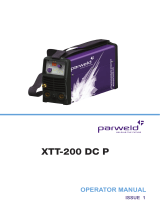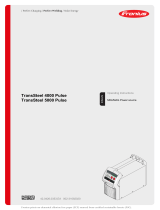
12
12
ENGLISH
A. SYNERGIC MODE: Press 13
Amperage: To carry out ne adjustment of overall power, master
amperage control located on the upper portion of the front panel
of the spooler, buttons No. 12 and No. 13 may be actuated.
These controls are duplicated on the main machine, group No.
17.
Voltage: To carry out ne adjustment of the feature of the arc,
actuate voltage master control No. 13 located on the lower
portion of the front panel of the spooler. When turning the control
to the left, voltage will be reduced whereby the arc is closed
and deposition in short-circuit mode will take place with high-
penetration, minimum projections and a characteristic sound.
According voltage is increased, there will be a tendency to high-
performance spray welding mode with a more silent sound, You
are recommended to start regulating voltage just at the middle
point indicated by a white point within the scope marked in the
synergic mode.
Wire speed: The amperage control modies at the same time the
wire discharge speed in accordance with the working conditions
indicated to the machine. When, due to special circumstances,
it should not be possible to adjust the exact speed, a speed
increase or decrease may be selected by adjusting the wire
diameter to the size that is immediately above or below that
which is really installed.
B. MANUAL MODE: Press 13
- With the knob 6 you can adjust the output speed of the thread
from 1.6m / s to 20m / s
- With the knob 9 you can adjust the output voltage of the device
from 13V to 40V
SPLASH CONTROL
Electric inductance 10 allows reducing splashes from the wire
welding process. Try empirically by raising or lowering the control
until achieving the best result.
4.4. Limits regarding the size of the workpiece
The main restriction regarding the piece to be welded is its
thickness which is limited by the power of the equipment.
At increasing power, you will be able to make correct welds (with
suitable penetration of the welding bead) on pieces of increased
thickness.
The following table may serve you as an orientation:
KINDS OF MMA WORK
PIECE
THICKNESS
ELECTRODE SETTING
1,5 - 5 mm 2,0 - 3,25 mm 40 - 140 A
2,5 - 5 mm 4,0 mm 120 - 190 A
5 - 12 mm 5,0 mm > 180 A
KIND OF MMA WORK
WIRE PIECE THICKNESS
0,6 mm 1 - 8 mm
0,8 mm 2 - 10 mm
1,0 mm 2 -25 mm
1,2 - 1,6 mm 5 - 50 mm
4.5 General instructions for use
4.5.1 Specic instructions MMA welding (shielded
electrode)
In this class of electric arc welding, the electrode itself produces
heat in the form of an electric arc, the shielded environment,
and it improves the weld puddle and the ller metal itself as the
electrode’s metal core progressively melts as welding is carried
out.
You have to choose the electrode (size and type) that is suitable
for carrying out the work to be performed.
An electrode we recommend due to its medium quality, suitability
for most works and for being easy to nd, is electrode E-6013,
popularly known as the “rutile electrode”. The material par
excellence for welding with shielded electrode is carbon steel.
After having conrmed all safety measures and inspected the
equipment, prepared and fastened the piece to be welded,
cables are connected according to the indications in the tables.
For the usual case of an E-6013 electrode, the output of negative
polarity (marked -) shall be connected to the piece by means of
the grounding clamp. The output of positive polarity (marked +)
shall be connected to the electrode carrier clamp the working
electrode is connected to the bare end thereof.
The welder will put on his/her individual protective equipment
using a welding mask or helmet that is suitable for the work, and
suitably covering any portion of his/her skin to avoid splashed
or radiation.
Welding shall be started by priming the arch. There are several
proceedings, the simplest of which is scratching the piece.
Once the arc has commenced, the electrode shall be kept at a
distance approximately equal to the diameter of the electrode as
such, and advancing of the weld shall be commenced by drawing
backwards as if a right-handed occidental person started writing,
The electrode shall be held in a position close (65o to 80o) to
the vertical with respect to the horizontal and balanced with
respect to weld puddle center. Depending on the kind of weld
pass (initial or lling) and the need of covering the joint, advance
in a straight line, zigzag movement or little circles. Good setting
of intensity, position and advance speed of the weld will result
in a pleasant, gentle sound, similar to that of a good barbecue
roast. When performing an accurate work, the resulting bead will
be homogeneous, with uniform surface marks shaped as half
moons.
Once the bead has been made, remove slag with a hammer and
brush before making the subsequent bead.
4.5.2 Specic instructions TIG welding
In electric arc welding by means of a inert-gas-protected tungsten
electrode, the consumable material is not the electrode itself but
a material ller rod similar to, or compatible with the material
to be welded. Compared with the shielded electrode system,
this system has greater productivity and greater diculty in
exchange for very high weld quality on almost any metal and
alloys thereof, including all stainless steels and situations of
joints of low thickness with or without ller material. Welding
takes place without slag, projections or smoke.
In order to correctly position the electrode in the torch, it must
protrude about 5 mm above the nozzle.
As a general rule, connect the output inversely than the usual
connection of the electrode i.e. the TIG torch to the equipment’s
negative terminal and the grounding clamp to the positive
terminal. Prepare and secure the piece.


















